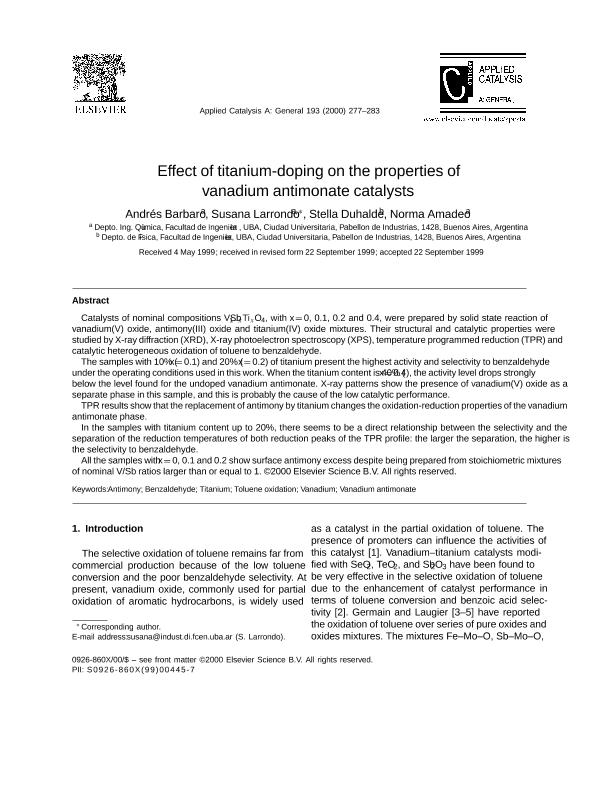Mostrar el registro sencillo del ítem
dc.contributor.author
Barbaro, Andrés
dc.contributor.author
Larrondo, Susana Adelina

dc.contributor.author
Duhalde, Stella Maris

dc.contributor.author
Amadeo, Norma Elvira

dc.date.available
2019-03-14T20:05:46Z
dc.date.issued
2000-02
dc.identifier.citation
Barbaro, Andrés; Larrondo, Susana Adelina; Duhalde, Stella Maris; Amadeo, Norma Elvira; Effect of titanium-doping on the properties of vanadium antimonate catalysts; Elsevier Science; Applied Catalysis A: General; 193; 1-2; 2-2000; 277-283
dc.identifier.issn
0926-860X
dc.identifier.uri
http://hdl.handle.net/11336/71705
dc.description.abstract
Catalysts of nominal compositions VSb1 - xTixO4, with x = 0, 0.1, 0.2 and 0.4, were prepared by solid state reaction of vanadium(V) oxide, antimony(III) oxide and titanium(IV) oxide mixtures. Their structural and catalytic properties were studied by X-ray diffraction (XRD), X-ray photoelectron spectroscopy (XPS), temperature programmed reduction (TPR) and catalytic heterogeneous oxidation of toluene to benzaldehyde. The samples with 10% (x = 0.1) and 20% (x = 0.2) of titanium present the highest activity and selectivity to benzaldehyde under the operating conditions used in this work. When the titanium content is 40% (x = 0.4), the activity level drops strongly below the level found for the undoped vanadium antimonate. X-ray patterns show the presence of vanadium(V) oxide as a separate phase in this sample, and this is probably the cause of the low catalytic performance. TPR results show that the replacement of antimony by titanium changes the oxidation-reduction properties of the vanadium antimonate phase. In the samples with titanium content up to 20%, there seems to be a direct relationship between the selectivity and the separation of the reduction temperatures of both reduction peaks of the TPR profile: the larger the separation, the higher is the selectivity to benzaldehyde. All the samples with x = 0, 0.1 and 0.2 show surface antimony excess despite being prepared from stoichiometric mixtures of nominal V/Sb ratios larger than or equal to 1. © 2000 Elsevier Science B.V. All rights reserved.
dc.format
application/pdf
dc.language.iso
eng
dc.publisher
Elsevier Science

dc.rights
info:eu-repo/semantics/openAccess
dc.rights.uri
https://creativecommons.org/licenses/by-nc-sa/2.5/ar/
dc.subject
Antimony
dc.subject
Benzaldehyde
dc.subject
Titanium
dc.subject
Toluene Oxidation
dc.subject
Vanadium
dc.subject
Vanadium Antimonate
dc.subject.classification
Otras Ingeniería Química

dc.subject.classification
Ingeniería Química

dc.subject.classification
INGENIERÍAS Y TECNOLOGÍAS

dc.title
Effect of titanium-doping on the properties of vanadium antimonate catalysts
dc.type
info:eu-repo/semantics/article
dc.type
info:ar-repo/semantics/artículo
dc.type
info:eu-repo/semantics/publishedVersion
dc.date.updated
2019-03-14T14:14:23Z
dc.journal.volume
193
dc.journal.number
1-2
dc.journal.pagination
277-283
dc.journal.pais
Países Bajos

dc.journal.ciudad
Amsterdam
dc.description.fil
Fil: Barbaro, Andrés. Universidad de Buenos Aires. Facultad de Ingeniería. Departamento de Ingeniería Química. Laboratorio de Procesos Catalíticos; Argentina
dc.description.fil
Fil: Larrondo, Susana Adelina. Consejo Nacional de Investigaciones Científicas y Técnicas; Argentina. Universidad de Buenos Aires. Facultad de Ingeniería. Departamento de Ingeniería Química. Laboratorio de Procesos Catalíticos; Argentina
dc.description.fil
Fil: Duhalde, Stella Maris. Consejo Nacional de Investigaciones Científicas y Técnicas; Argentina. Universidad de Buenos Aires. Facultad de Ingeniería. Departamento de Física; Argentina
dc.description.fil
Fil: Amadeo, Norma Elvira. Consejo Nacional de Investigaciones Científicas y Técnicas; Argentina. Universidad de Buenos Aires. Facultad de Ingeniería. Departamento de Ingeniería Química. Laboratorio de Procesos Catalíticos; Argentina
dc.journal.title
Applied Catalysis A: General

dc.relation.alternativeid
info:eu-repo/semantics/altIdentifier/doi/https://doi.org/10.1016/S0926-860X(99)00445-7
dc.relation.alternativeid
info:eu-repo/semantics/altIdentifier/url/https://www.sciencedirect.com/science/article/pii/S0926860X99004457
Archivos asociados
